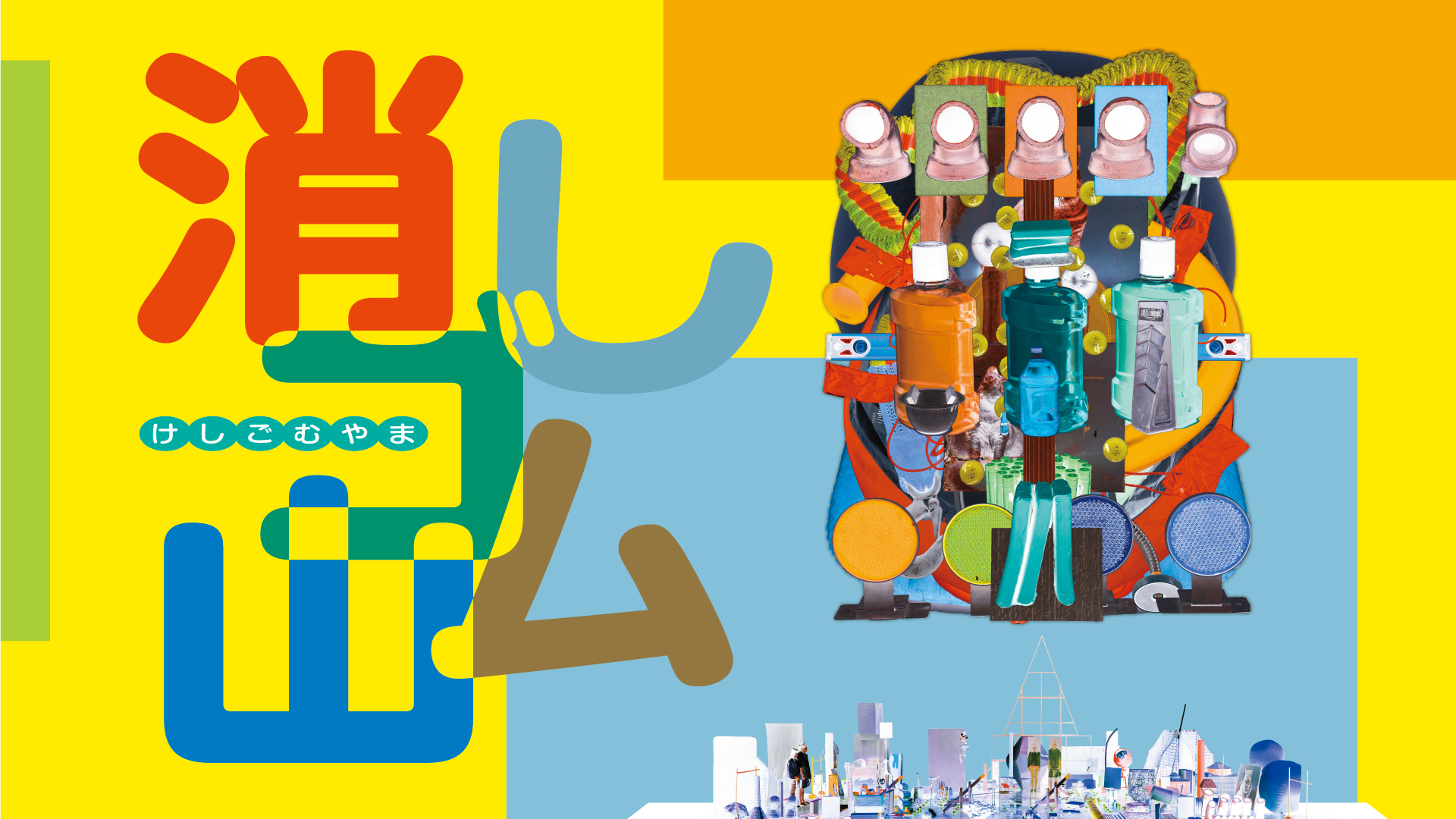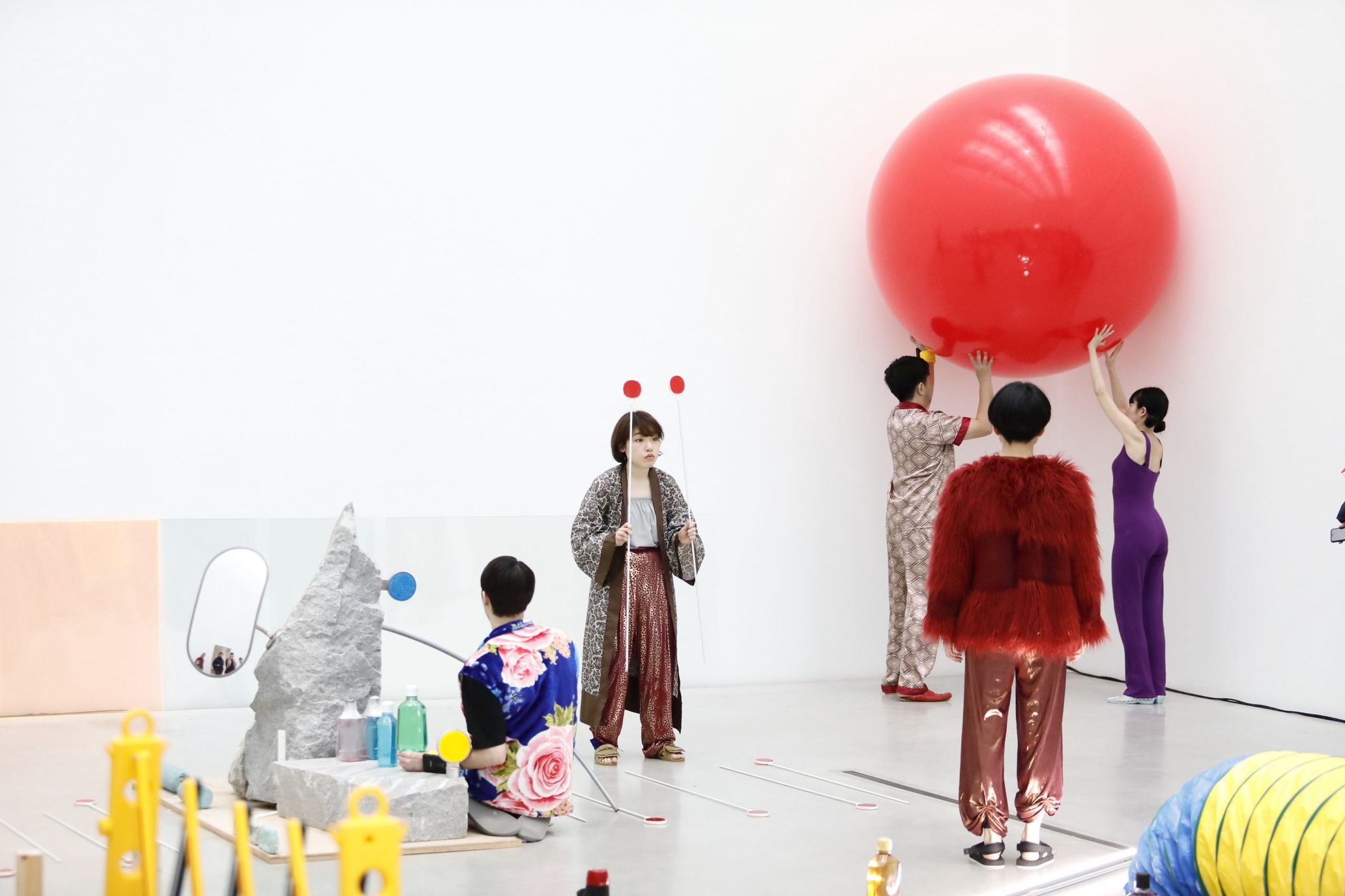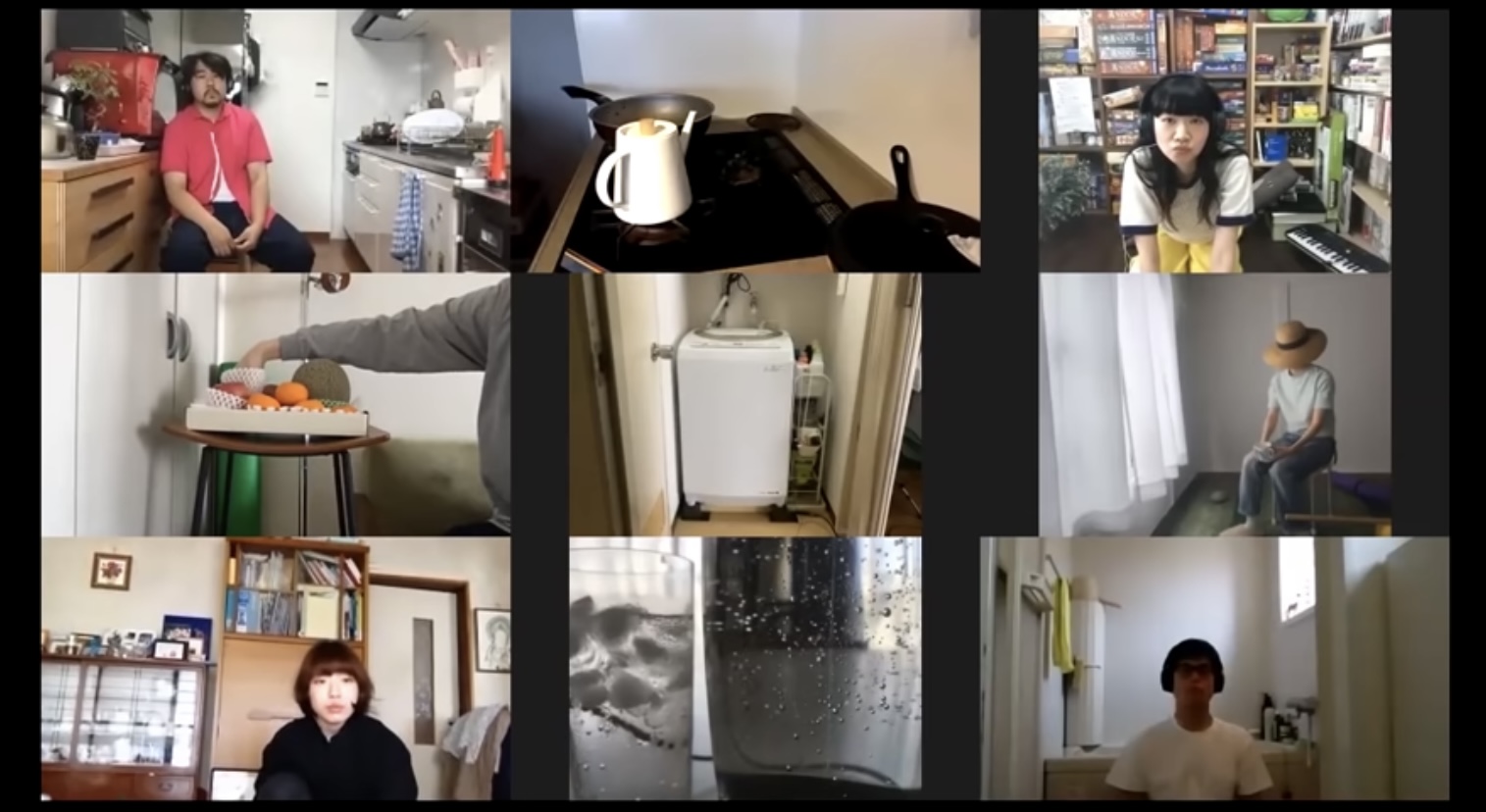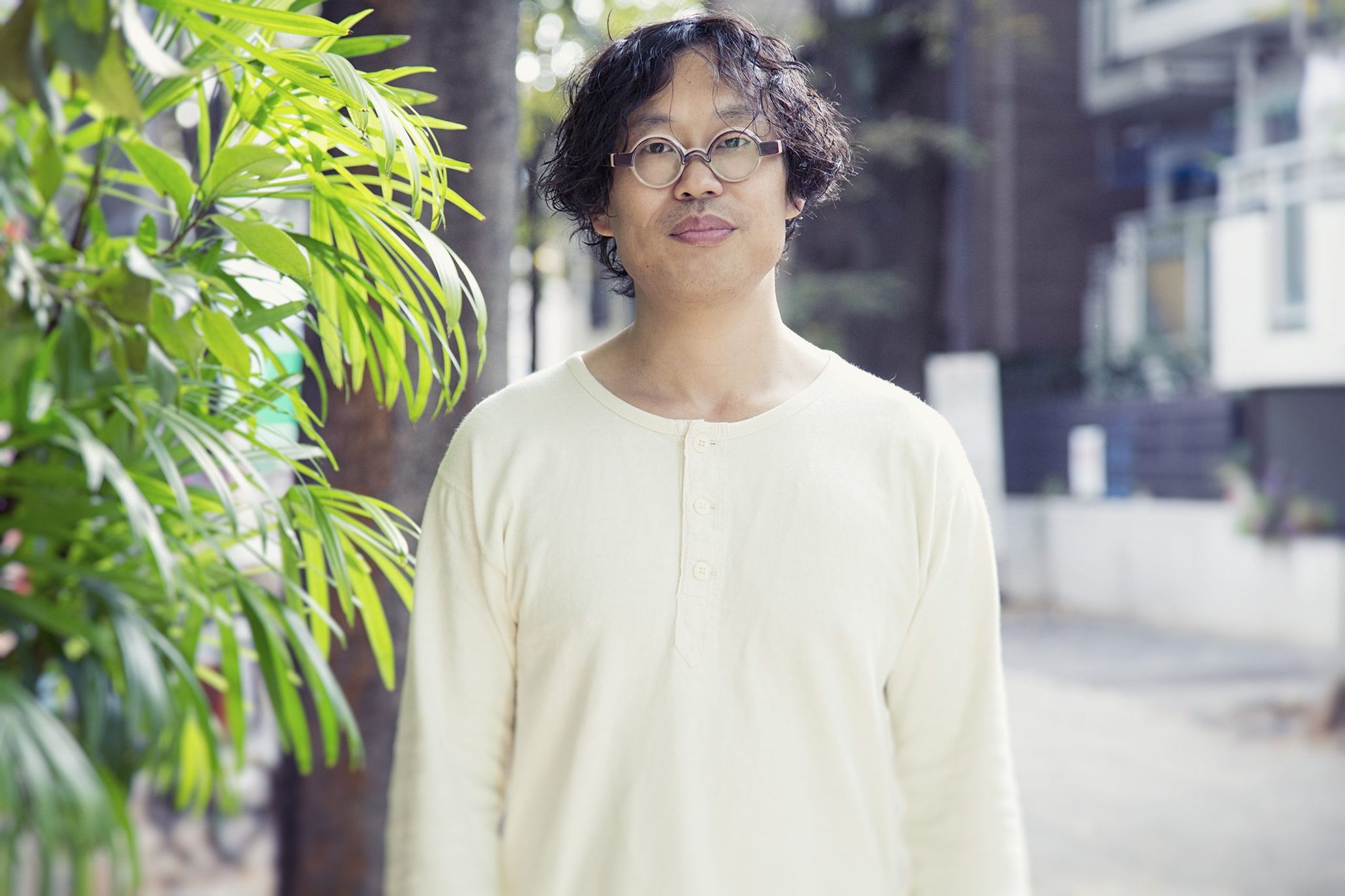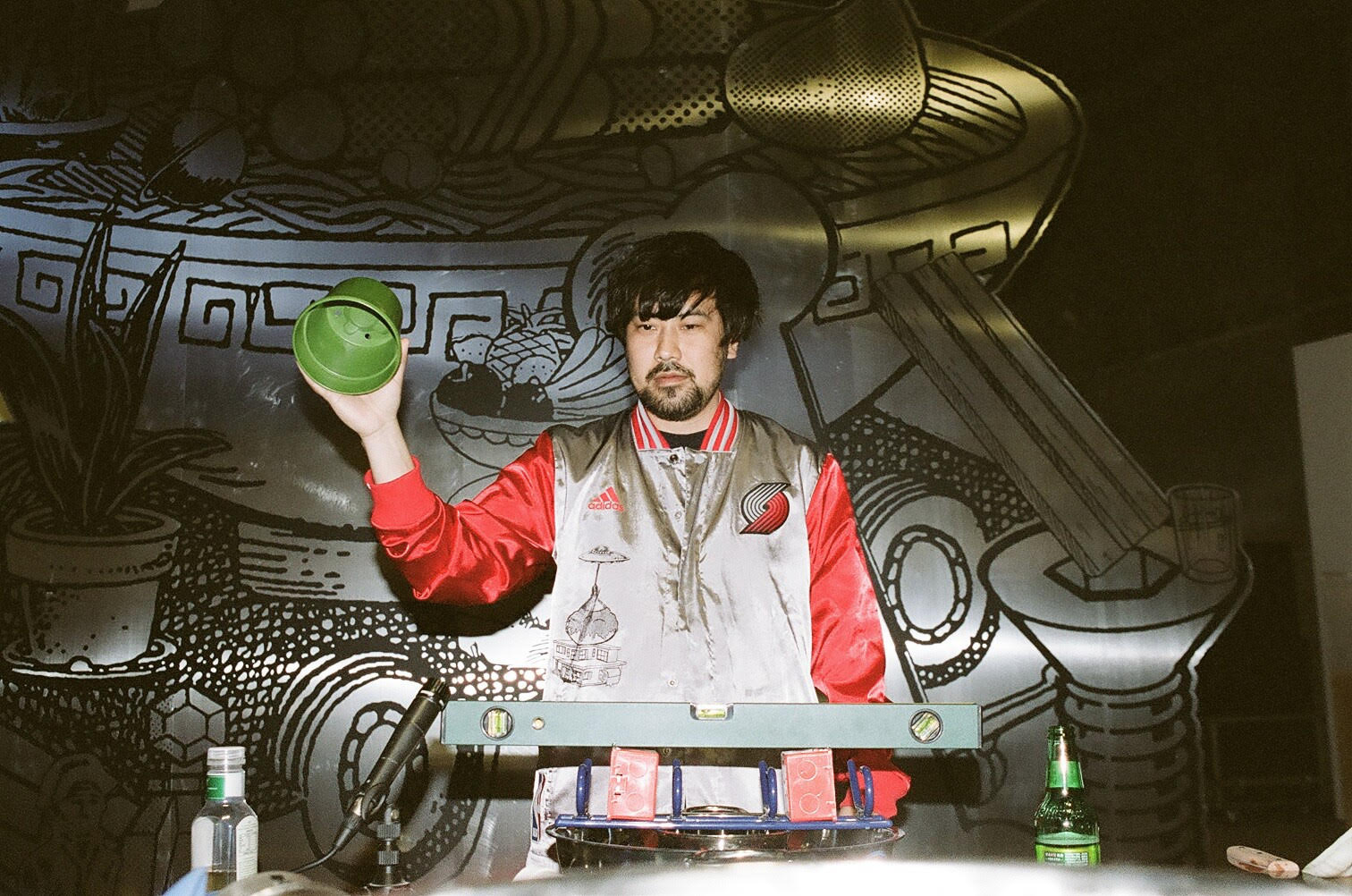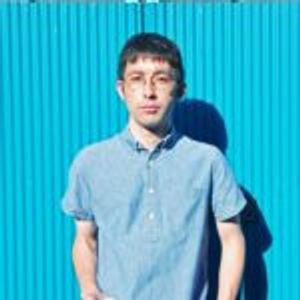Playwright Toshiki Okada’s theatre company chelfitsch has been working in tandem with artist Teppei Kaneuji for their theatrical performance, Eraser series. This year, the very latest in the series, Eraser Mountain, has opened in Tokyo. Through the Eraser series—that convey the new ties among humans, things, space and time, and attempt to leave anthropocentricity—what are the challenges lying ahead in the future of humans? The question is unraveled by the words of Okada and Kaneuji.
The keyword ‘semi-transparent’ born from giving a significant amount of thought to the interaction with the actors
――I heard that the first time you two worked together was in 2011 for chelfitsch’s play Impossible To Understand You, It’s Almost like Electrical Devices. First, can you tell me the reason why you decided to welcome Kaneuji as a scenic designer for the play?
Toshiki Okada:Whenever I’m putting out a play, I always don’t know what to do with the scenic design. For me, in most cases, I’m not like, “I want this particular set.” But I also don’t want it to be abstract, as that would appear too rough. I just can’t explain what I look for in stage designs with words. Anyway, I always anguish on this matter. And if it can’t be done by myself, I need to ask for someone’s help, and Kaneuji is the right man to ask.
Teppei Kaneuji:When I worked for Impossible To Understand You, It’s Almost like Electrical Devices, that was my first time stepping into the world of scenic design. I began by checking out chelfitsch’s plays right after I got the offer, but the more I watch the more I felt there’s no need of scenic design. Especially, the old chelfitsch plays are well done without any set designs. But, Okada is vigorously challenging things that go beyond the scope of my assumptions, and I’m working with him not only because I’m being needed, but hoping to find joy in it. Including tower, which by the way was led by me, it’s my fourth time working together with Okada, and I know he’s the type of artist who loathes repeating the same thing, so there’s always a new challenge; and I feel the efforts are eventually echoed in my own projects, so it’s worth challenging positively with him.
Okada:I’ve realized since Kaneuji told me that, essentially, we don’t need set designs. However, I think it would be boring if we didn’t have any. I’d like to believe that ‘it could be done with or without it’ instead of ‘it’s there because it’s needed.’ I just noticed as I speak—I’m pretty much saying: “The production can be done without you” to a scenic designer. If I say such rude thing to other scenic designers, they would be like “Okay, goodbye then,” but I’m grateful to have a scenic designer who tells me, “If that’s the case, we can make something way better.” So, I work with Kaneuji not because I want him to help me, but because he’s capable of accomplishing the part that can’t be done by myself, and I want him to take the helm on that part. Language is not enough to describe the difference, but it’s a huge difference having him on board.
Kaneuji:I understand what you mean. Normally, I collage various things and I’m basically welding different elements together into one, so I really understand that feeling of ‘it could be done with or without it.’ I’m aware that it’s not about scraping off excess, it’s about the comfort of having the possibilities of various elements coming together—so that’s why I was able to take your remark in a positive way.
――In the past, there were times where Kaneuji did the set designs for chelfitsch’s plays, and Okada provided texts for Kaneuji’s works, yet Eraser Mountain is a collaboration project between you two. How did this unique play come about?
Okada:Concisely speaking, I told Kaneuji that the set doesn’t need to be relevant to the play at all. In fact, I wanted it to be ‘annoyingly in the way.’ When we say ‘it could be accomplished with nothing,’ that also implies ‘it could be accomplished with an obstacle.’
Kaneuji:This time, I intended to make things to be in one another’s way. There were things blocking the sight and placed precariously on purpose to make the objects and performances coexist on stage in parallel, and even there was nothing happening on stage, there was still something sitting on the stage—that’s what I was intending.
Okada:I wrote Eraser Mountain after I witnessed the reconstruction work of Rikuzentakata in 2017. As a countermeasure against future tsunami, the town is undergoing construction to elevate the land over ten meters higher than where it was before. When I was on site and seeing the view changing rapidly and artificially, my doubts toward ‘criteria used by humans’ began to raise.
Also, there’s another story about when I was eating at a terrace seat at a restaurant, a fly flew to my table. Normally, I would beat it away like others would do, but at that time I was somewhat not in the mood to do so. The place was a place to dine for me, but I knew it wasn’t for the fly—I wanted to convey these sentiments on stage, and that’s how Eraser Mountain came about.
――Specifically, what kind of efforts were put in to successfully portray those sentiments in the play?
Okada:I have almost no idea what Kaneuji did to bring my ideas to fruition, but speaking of what I did was not letting the actors perform for the audience. I made them look away from the audience when saying the lines and perform not to the audience but look upwards when performing. In the beginning, all the actors were lost with my idea, but at least that was my aim from the start.
Kaneuji:There were multiple ideas I came up on my end as well. For example, the objects are deliberately placed in the way they are. The objects are usually placed on stage with certain context and rules, but I placed them in order to become estranged from their original purposes and made sure they don’t find themselves a new story. It was quite difficult, because even though they all seem to be random and abstract, they can easily make themselves look somewhat relevant. So, these things are placed in the way to avoid the audience from referring them to something. Also, I didn’t want them to be seen as ‘the things merely lying on stage’, but rather wanted them to appear as a piece of the vast wilderness. In order to achieve this idea, I didn’t hesitate to place them boldly even if they blocked the sight. For instance, I placed the monument, Christmas tree, tombstone and wooden pillar, randomly so that the territories of these things get mashed up that they become almost irrelevant.
Okada:There are so many ideas implemented in the set that I still don’t know about, and it was my first time hearing that story. Pragmatically speaking, it’s difficult to completely take away the meanings of these objects, but it’s interesting to see the objects, that have strong presences like the Christmas tree and wooden pillar, placed in the same spot, conflicting with each other and eventually losing their essential meanings—They’re like getting in each other’s way.
Kaneuji:While I was giving a significant amount of thoughts on the ways of placing these things, and how to link my ideas with Okada’s, I was given the opportunity to do a workshop led by me. When we were discussing deeply about how we should interact with the actors, the word ‘semi-transparent’ came up as a keyword.
Photography Yuki Moriya
Things becoming visible through the process of developing in various forms
――Can you tell me more about that keyword:‘semi-transparent’?
Kaneuji:Originally, it was a word we used when analyzing the works by the photographer, Kotori Kawashima, which appear to us as idol pictures. For example, even if he took a picture of a view, it would still look like an idol photography. By the way, that’s what we mean by ‘semi-transparent’; and regarding Kawashima’s works, he lenses moments that look as if he captured them while his one foot was stepping in the other world, and that’s probably where the ‘idol-ness’ comes from. I thought that we could implement his style in the play, and at the workshop, based on what we studied from Kawashima’s works, I had the actors work in pairs, and have one person in each pair to establish a relationship with an object—and that person had to come up with a pose—and the other person would take a picture of that person. The purpose of turning half of themselves into an object, and the other half to be inexistent was for them to eventually find ways to perform towards somewhere other than the audience seats.
Okada:When we discussed about how we can free ourselves from anthropocentrism, we could have explained to the actors like, “It’s achieved when the relationship between humans and things become flat”—however, instead of explaining them so, it was more effective using the word ‘semi-transparent.’ The word ‘semi-transparent’ is more specific to them. When instructing the actors, if we told them to be ‘flat,’ they wouldn’t quite understand. It made more sense to them when we told them to be ‘semi-transparent.’ By discovering the intrinsic meaning of becoming ‘semi-transparent,’ they were able to obtain a very concise weapon. We would tell them: “That’s ‘semi-transparent,’ well done” or “You’re almost there [to be ‘semi-transparent’]”—it became an imperative word in the creative space. I think that was a huge accomplishment.
――Eraser Mountain has a theme of ‘extricating from anthropocentrism.’ The Eraser series have been brought into conversation among various media—how was the time performing a play that’s likely to become human centered, for both of you?
Okada:I would say there are so many texts out there that write about human issues, however, there aren’t still enough texts that focus on the outer factors. These outer factors are more crucial, and I’ve been trying to convey them but had no idea how to elaborate. Yet, I just did it anyway by manifesting: “I’m going to start a play that doesn’t center on humans.” Well, I‘ve said it out loud and it worked out. If I went on with an empty concept, it would’ve become a sheer embarrassment, however, we were able to discover what is intrinsic to a play that isn’t centered on humans, after going through the creative process. It’s a fluke that we were able to specify and be definitive with the ideas, and move forward with a blueprint at hand.
Kaneuji:After we did Eraser Mountain at the theatre, we did Eraser Forest, which was the performance of Eraser Mountain staged in a museum. During the two weeks, as the actors were performing for hours, I could see the actors were delving into the concept, and I was moved by that. Also, the tour was postponed due to Covid, but we were able to put out the performance Eraser Fields, book Eraser Stone, and novel “Eraser SHIKI” (double meaning of “Eraser Ceremony / Style”), which is novelized “Eraser Fields”. By constantly presenting works in different creative forms, I was able to see more things. I also think the tour being postponed due to the pandemic was very important for us, as we were able to keep our creations alive—instead of sleeping on them and just waiting for it to pass—and feel the flow of time. There were accidents during the period, where our set didn’t get delivered to New York, but it was really funny imagining the set of Eraser Mountain being trapped in the middle of the ocean. The timeline of Eraser Mountain was determined considering the circumstance, but that accident directly impacted us and made us even more aware of the situation.
――There were moments in Eraser Mountain where the actors spoke about time—in the Eraser series, what were your thoughts on time?
Okada:One day, I was talking to a musician, and that person said: “There’s no such thing as time. There’s only space.” When I heard that, I thought it might be right.
Kaneuji:I sometimes think about time when creating something, and for this performance, I realized that time is only part of a ‘scale.’ If you concentrate for a very long period of time, or heed every moment of time, it feels like time doesn’t actually exist. That’s what I felt especially for this performance. I think the Eraser series focus a lot about time, and moreover highlights various experiences born in multiple distances or spaces. The same idea is showcased in the other series, but I think it’s especially conspicuous in Eraser Mountain. It’s not like: “As Eraser Mountain is a completed work, it needs to be reflected as a relatable experience to the viewers or else it wouldn’t work out as a play”—yet instead, it’s a work that positively accepts the possibility of being assimilated as a completely different experience; and I feel that links to the idea of time that I was just talking about.
Okada:I genuinely agree with the word ‘scale’ that Kaneuji just mentioned. I handle eclectic ideas, but I think I always incorporate the idea of ‘scale.’ For example, the play Eraser Mountain was obviously shown on the scale of the physical space of the theatre. Also, there was a time frame of two hours. However, it’s certain that there are some ‘scales’ in the play that ignore the time frame or the restrictions. That’s probably one of the biggest factors that allowed me to achieve my goal of truly showcasing what I’d felt at Rikuzentakata, with Eraser Mountain.
Each and every one of the Eraser series is individualized
――The Eraser series have been presented in various media and spaces, and today, how do you feel about showing it on the scale of the theatre?
Okada:You need to obtain a lot of power to share a physical place with others. We genuinely feel so especially after such opportunities were taken away from us last year; the importance of theaters have been emphasized, and it’s like realizing the ‘importance of health’ when you get sick. In museums, you can perceive the time scale enough from those famous ancient paintings that have been around from hundreds of years ago, and you don’t necessarily need to trace all the way back to the cave paintings to feel the dynamics. However, in theaters, all matters are temporarily created and only last in the moments. And I think it’s worth overcoming the challenges that only arise in theaters. After we put out Eraser Mountain in Kyoto, we did Eraser Forest in Kanazawa—and that felt right. Also, I was confident from the start that presenting the Eraser concept under the system of museum was going to work out. I think it’s rather challenging to perform Eraser Mountain in a human-centered place like theaters. For the Tokyo performance, I was relatively happy that we were able to accomplish up to a certain point.
――For Eraser Mountain—which was performed at the theater in Ikebukuro in February—there were various services that made the space of the theater more welcoming to guests: such as you did workshops before performances, provided audio guides, decreased barriers to make the theater more accessible for people with disabilities, and scheduled performances with“Performances with low viewing-manner hurdles” What did you acquire from executing these services?
Okada:I felt potential and success with the performances with the ‘low viewing-manner hurdles.’ Because just by notifying the audience that it’s a performance with ‘a low viewing-manner hurdles,’ they would become more laid-back as the bar was instantly set low for them. It felt like a conceptual art or instruction art.
Kaneuji:For this performance, we did livestreaming, had audio-guides, and organized workshops. Yet eventually, they all became an individual artwork instead of just mediums to assist people to further understand Eraser Mountain. I was very fascinated by the outcome. It was fun seeing each medium as a unique work, and they were not only contributing to make the performance multifaceted, but naturally morphing into various forms of art through catering to people from different distances, and with diverse situations, and conditions.
Okada:We’ve done livestreaming for this performance, but there weren’t that many viewers. It’s a shame. I’ve realized that we garner more audience at physical places, and the importance for people to make extra efforts of planning and scheduling to got to the theater, as they feel more rewarded that way.
Kaneuji:The livestream performance itself was great, but it just wasn’t seen much.
Okada:By the way the livestream video is titled Eraser Mountain is Watching, and you can watch the archived video. I would love for people to watch it.
Playwright, Director
Born in Yokohama in 1973, Toshiki Okada currently lives in Kumamoto. His work has attracted attention for the way in which it overturns the conventions of theatre. He was awarded the 49th Kishida Kunio Drama award for “Five Days in March” ,the 2nd Oe Kenzaburo Award for “The End of the Special Time We Were Allowed,” his debut novel and the 27th Yomiuri Theater Awards Selection Committee Special Prize with his Thai artists-collaboration piece “Pratthana – A Portrait of Possession,” which is an adaptation of a novel by Thai author Uthis Haemamool.
His other plays and publications include “Current Location” and a collection of theatre theory. From 2016, he directed works in a repertory program at Münchner Kammerspiele for four consecutive seasons. “The Vacuum Cleaner” has been selected as one of the “ten remarkable productions” by Theatertreffen 2020, the German theater festival.In 2021, he won The Yomiuri Bungaku-sho (prize for literature) with “Unfulfilled Ghost and Monster – ZAHA / TSURUGA”.
Photography Kikuko Usuyama
Born in 1978 in Kyoto. In 2001, while he was studying at Kyoto University of Arts, he earned an opportunity of an exchange program to study at Royal College of Art (London, UK). In 2003, he graduated Kyoto University of Arts, finishing the master’s degree in sculpture. He currently garners everyday life objects and creates art by collaging. He also perseveres to achieve a new form of sculpture that reveals the consistent relation between substances and images, through a variety of forms including illustration, videography, and photography. His recent exhibitions are: En/trance (at Japan society in New York, 2020-2021), Plastic Barricade (at Jane Lombard Gallery in New York, 2019), Hair, Plastic and Gold (at haku in Kyoto, 2019), Summer Fiction (at Art Front Gallery in Tokyo, 2018), and more.
Photography Kotori Kawashima
■Eraser Stone
The book version of the Eraser series that coalesces the documentations of the play Eraser Mountain and performance Eraser Forest, interviews, and critic reviews—an essential guide to unravel the contexts of the series.
Price:JPY2,000
Specification 1:A4 size
Total number of pages:144 pages
Specification 2:Japanese and English
Publish:SHUKYU
■“Eraser Mountain” streaming ver. “Eraser Mountain is watching”
Currently livestreaming at the barrier-free platform, THEATER for ALL. It is another version of Eraser Mountain that cannot be experienced in theaters, embodying the concept of Eraser seriesand delivered by a unique approach through video-streaming.
Date:February 22 – April 30th, 2021
Subtitles:Japanese and English / 155minutes of run time
Ticket:JPY1,800
Livestream link URL:
https://theatreforall.net/movie/erasermountain_archive
Translation Ai Kaneda

